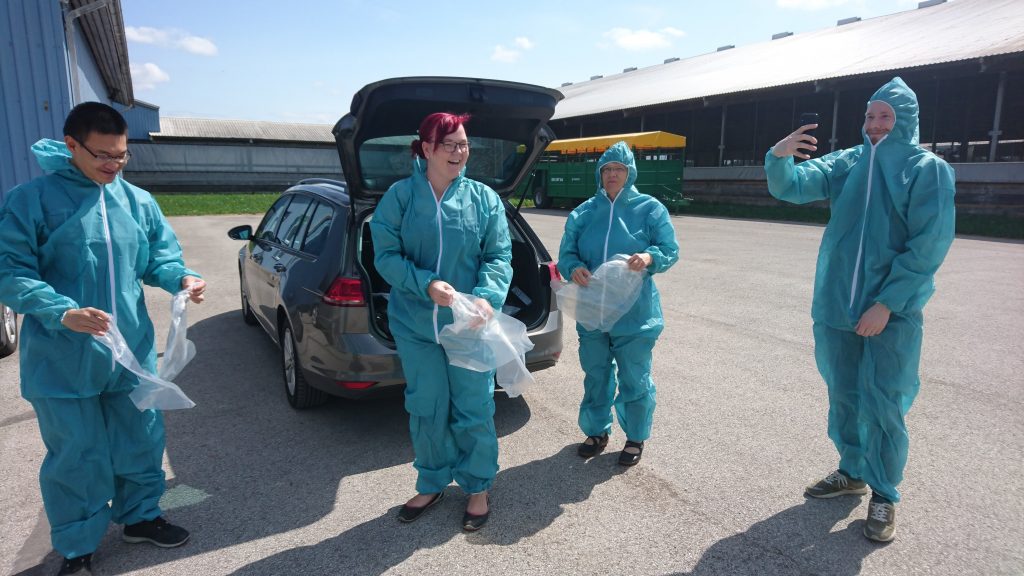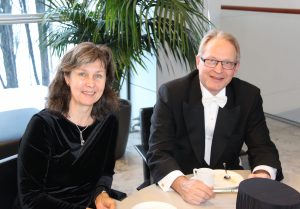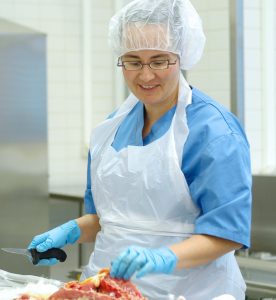Professor Tomi Taira continued serving as director of department.
Two new Helsinki One Health professors were appointed on the tenure track in the field of the Department or closely associated with it: Assistant Professor Tarja Pääkkönen specialises in the comparative study of diseases, while Associate Professor Tarja Sironen’s speciality is emerging infectious diseases.
The Department’s operations are carried out at two campuses, with the disciplines of anatomy, physiology, biochemistry and pathology at Viikki and the disciplines of genetics and microbiology at Meilahti.
Anatomy and developmental biology
Professor Antti Iivanainen, head of discipline, and University Lecturer Mikael Niku continued their research on the early development of intestinal microbiota and the immune system. A report on their work was published in the Scientific Reports journal, in addition to which their efforts were presented in international conferences in microbiology and mucosal immunology. Productive cooperation with the animal science unit in Viikki, the Jokioinen research centre of Natural Resources Institute Finland, as well as the University of Tartu and Ghen University continued, while research cooperation focusing on canine bone diseases continued with Hannes Lohi’s research group.
As part of the HiLIFE research organisation, University Lecturers Tiina Pessa-Morikawa and Mikael Niku maintained flow cytometry and laser microdissection activities, the core services for research coordinated by the Faculty.
Findings from Pessa-Morikawa’s research cooperation with Minna Rajamäki’s group were accepted for publication in the Journal of Veterinary Internal Medicine.
In the research projects focused on macroscopic anatomy headed by University Lecturer Juha Laakkonen, a significant contribution was made by licentiate theses completed by students. Laakkonen has continued his pedagogical investigations by looking into students’ perceptions of knowledge. A new virtual microscopy system was deployed, while a related teaching specimen collection was expanded. The service serves as a pilot for a joint virtual microscopy service to be potentially used throughout the University. Mikael Niku received excellent feedback on the online streaming and video recording of his lectures. Luupeli (luupeli.herokuapp.com), a digital game for learning bone-related terminology, was completed in cooperation with the University of Helsinki’s Department of Computer Science. Students were responsible for programming the game, while the conceptual design and pictorial material were the remit of Tiina Pessa-Morikawa.
Mikael Niku represented Viikki Campus on the board of the Teachers’ Academy and served as a member of the Faculty Council. Antti Iivanainen served as the director of the Bachelor’s Programme in Veterinary Medicine, a member of the committee for research and postgraduate research, the Faculty’s representative in entrance examination activities as well as a member of the steering group of the MD PhD Programme.
Santeri Suokas returned from a study leave and began working as a joint senior laboratory technician for anatomy and developmental biology, as well as biochemistry and cell biology. In the discipline of anatomy, he coordinated the operations of the histology laboratory. As during the previous year, Senior Laboratory Technician Kirsi Lahti was responsible for the discipline’s research laboratory.

Antti Iivanainen’s research group collaborated with Tartu Veterinary. Pictured are Nanbing Qin, Elisabeth Dorbek-Koli, Tiina Pessa-Morikawa and Aleksi Husso on a cattle farm in Tartu.
Biochemistry, cell biology and genetics
The discipline of genetics, headed by Professor Hannes Lohi, was merged with the disciplines of biochemistry and cell biology, headed by Professor Jyrki Kukkonen, into a joint discipline of biochemistry, cell biology and genetics.
Biochemistry and cell biology
Research participation for Professor Jyrki Kukkonen, the discipline supervisor, included projects focused on orexins and their receptors, as well as related pathologies. During the spring and autumn terms, Kukkonen was on study leave, substituted in teaching duties by Docent Pirjo Nikula-Ijäs. In October, Kukkonen transferred to the Faculty of Medicine, University of Helsinki, to assume the professorship in pharmacology.
University Lecturer Marjo Salminen continued her research in cooperation with Juha Partanen (Faculty of Biological and Environmental Sciences, University of Helsinki) on brain development, focusing especially on the diversity of individual cells of the mesencephalon and metencephalon by using RNA profiling, supported by funding from the Sigrid Jusélius Foundation. The numerous nuclei in this brain region regulate behaviour, mood, memory and motion in animals. The nuclei contain a variety of neurons which primarily utilise gamma-aminobutyric acid or glutamate as neurotransmitters. The differentiation and development of the diversity of these neurons is not well known, nor are the factors regulating this diversity. The goal of this project has been to identify the genes that the neurons in these nuclei express, and the ways in which their diversity is guided by genes.
Genetics
In the discipline of genetics, international cooperation continued very actively in the form of some 30 articles that were published or submitted for publication, offering a broad range of clinical and genetic findings pertaining to hereditary canine and feline diseases. Among the publications were also articles on gene databases as well as tools of bioinformatics and metabolomics. From among the most significant genetic findings, deserving of particular attention are the breakthroughs associated with canine hip dysplasia achieved in cooperation with Professor Antti Iivanainen’s group, a gene finding linked with a lung disease occurring in Airedale Terriers, a retinal atrophy gene in Miniature Schnauzers, gene loci associated with fearfulness in German Shepherds, a hypophosphatasia gene in Karelian Bear Dogs and a hairlessness gene in Scottish Deerhounds. Further, the project focused on canine and feline behaviour also progressed well.
In December 2019 Maria Kaukonen, LVM, defended her doctoral dissertation on the genetics of canine ocular diseases. The discipline received a lot of publicity through central media channels, including the YLE and MTV broadcasting companies, while SEY Animal Welfare Finland awarded one of the research groups its annual prize for promoting animal welfare. Professor Lohi was invited to become a member of the Finnish Society of Sciences and Letters. The discipline is continuing its research efforts in genomics, transcriptomics and metabolomics, with significant breakthroughs as well as a number of doctoral dissertations expected in 2020.

The people of the DoGA project in the collective picture. The aim of the project is e.g. improve the genetic map of dogs.
Physiology
The research group headed by Professor Tomi Taira, discipline supervisor, continued its activities in the field of neurophysiology, focusing particularly on the role of kainate-type glutamate receptors in the regulation of developmental brain plasticity. Together with its partners, the group received nearly €800,000 in project funding from the Academy of Finland for the term 2019–2022 for research on the developmental physiology of the brain. Thanks to this funding, two new postdoctoral researchers, Patricia Seja and Tatjana Kuznetsova, began working in the group in 2020. In collaborative projects, the group has continued cooperation with Professor Timo Otonkoski and Professor Henna Tyynismaa on the use of neurons and organoids differentiated from human-induced pluripotent stem cells (hiPSC) in the study of diseases of the central nervous system.
Cooperation has also continued with Aalto University, specifically pertaining to the use of nanofibre materials in the diagnostics and treatment of brain diseases. The group’s research reports were published in the Molecular Neurobiology, Neurochemical Research and Diamonds and Related Materials journals.
University Lecturer Tiina Kukko-Lukjanov and Senior Laboratory Technician Kirsi Kolehmainen have shared the responsibility for the electrophysiological study of organotypic brain slices and cell cultures, as well as the maintenance of related laboratory infrastructures. They have also been responsible for coordinating coursework related to teaching.
Professor Taira is participating in the degree structure reform as a representative in the steering groups of both the Degree Programme in Veterinary Medicine and the Master’s Programme in Neuroscience (Faculty of Biological and Environmental Sciences). Taira has also served as a steering group member in the Doctoral Programme in Clinical Veterinary Medicine. In addition, Taira is serving as the Faculty’s representative (in biology) in the national entrance examination committee.
Microbiology and epidemiology
Professor Olli Vapalahti served as supervisor for the discipline.
The research group of Vapalahti, Associate Professor Tarja Sironen and Docent Eili Huhtamo, investigates new and emerging infections, particularly viral infections transmitted by rodents and bats, as well as arboviruses, or viruses transmitted by arthropods. The group contributed to education in veterinary virology, with Olli Vapalahti as the coordinating teacher. In January and February 2019 researchers from the group visited the University of Nairobi and the Taita Research Station of the University of Helsinki in Kenya. Additionally, the group contributed to the organisation of the European Meeting on Viral Zoonoses held in Saint-Raphaël, France, in late September and early October.
During the year, the discipline produced roughly 20 publications, including an article on the discovery of the novel Bombali ebolavirus in Kenyan bats published in the Emerging Infectious Diseases journal (Forbes, EID 2019). However, the study found no evidence of related infections in humans. Under the direction of Tarja Sironen, this project employs Ilkka Kivistö and Lauri Kareinen, as well as Joseph Ogola, a visiting doctoral student.
A genetic analysis on the occurrence of tick-borne encephalitis in the Helsinki Metropolitan Area, based on tick data collected in nature and through citizen science efforts, demonstrated that the virus has been most likely imported by migratory birds in several individual instances. However, its prevalence has slightly increased in recent years (Smura, EMI 2019).
By employing the means of deep sequencing and bioinformatics, the Alongshan virus, a novel virus proven in China to be a human pathogen, was discovered in Europe, specifically in the Kotka Archipelago (Kuivanen, Eurosurveillance 2019). The group has continued to investigate the genetics, evolution and epidemiology of animal pathogens, focusing, among other things, on the whole genome of Streptococcus halichoer in cooperation with Merja Rantala and as part of Kirsi Aaltonen’s doctoral dissertation (Aaltonen 2020). Under the direction of Tarja Sironen, a potential parvovirus vaccine for foxes (Anna-Maria Moisander-Jylhä) and the tolerance mechanisms of AMDV infections (Jenni Virtanen) are under investigation.
Eili Huhtamo guided studies on mosquito-borne viruses on the basis of mosquito and patient datasets collected in Finland and Kenya. These projects employed postdoctoral researcher Essi Korhonen, doctoral student Ruut Uusitalo, MSc, and Maija Suvanto, a master’s level student in microbiology. Suvanto’s master’s thesis isolated and analysed the Sindbis viral strains of summer 2018, with the results presented in the late spring at the European Congress of Virology in Rotterdam, the Netherlands. During the summer of 2019 new mosquito data was collected in the Ostrobothnia region in western Finland and Helsinki. In September Essi Korhonen and Eili Huhtamo visited a partner laboratory in Novara, Italy. Other topics investigated in 2019 included specimens collected from febrile patients collaboratively with the University of Nairobi in Kenya. It turned out that the dengue virus serotype 2 (DENV-2) caused cases of febrile disease among the residents of remote areas in Kenya where the dengue virus was not previously known to occur. The virus was isolated from clinical specimens, and an analysis of its molecular epidemiology revealed that the virus had its origins in India (Masika, PNTD 2020).
University Lecturer Sami Junnikkala’s research, conducted in cooperation with the Saari unit’s pig researchers and the industry, has been focusing on sow immunology and welfare. One of the doctoral students, Shah Hasan, defended his dissertation on the investigations, entitled Challenges of hyperprolificacy in the pig: colostrum and microbiota, while two related articles were published in autumn 2019. In his role as a supervising teacher, Sami Junnikkala actively contributed to the Faculty’s EAEVE evaluation, to the design of a new student supervision model for the University and, as its coordinating teacher, to the development of the Professional Growth of a Veterinarian course, which is being expanded.
University Lecturers Joanna Koort, Silja Åvall-Jääskeläinen and Anna-Maija Virtala as well as doctoral student Kristiina Suominen, LVM, work in the unit’s research project on the epidemiology and molecular epidemiology of the Capnocytophaga spp bacterium. The project is being carried out in cooperation with the Finnish Institute for Health and Welfare.
Virtala, Koort and Åvall-Jääskeläinen have headed a thesis workshop, contributing through it to the supervision of several licentiate theses. Additionally, Virtala has participated in two projects at the Teachers’ Academy, focused on supervisors’ emotions during the assessment process, for which one scholarly article has already been completed, and an assessment of cross-disciplinary theses on which a survey was conducted and an article is in the analysis and writing stage. Virtala has also contributed to providing instruction to doctoral students through both a seminar series on biostatistical and epidemiological methods as well as on individual courses organised by different doctoral schools.
Pathology and parasitology
The discipline is headed by Professor Antti Sukura.
In January 2019 veterinarian Hanna-Kaisa Sihvo, DVM, DECVP, defended her doctoral dissertation in veterinary medicine. Her dissertation, focused on wooden breast myopathy in broiler chickens, was completed in collaboration with a research group headed by Professor Emeritus Eero Puolanne from the Faculty of Agriculture and Forestry.


Qualifications among the teachers of pathology were enhanced, as Karoliina Hagner obtained a specialist degree in infectious animal diseases.
University Lecturer and Docent Anu Näreaho, who has coordinated the operations in parasitology, spent the year 2019 on a leave of absence, substituted by Docent Antti Lavikainen. Sara Kotka and Karoliina Jurvelin transferred from the histology laboratory to continue their studies, with Sara pursuing the veterinary profession and Karoliina moving on to study engineering in Tampere. They were replaced by histology specialists Laura Vähälä and Taneli Lohilahti. A breath of youthful air was brought by Tuuli Wahlström, our trainee veterinarian for the summer, while trainee Gianfilippo Agliani gave our discipline an international touch. In the autumn veterinarian Minna Söderström began working in the teacher/pathologist/researcher team. Thank you to all those who moved on to other positions for the wonderful contribution you made to the operations of the discipline!
University Lecturer Heli Nordgren, DVM, who carries a special responsibility for production animal pathology, prepared during the year to apply for funding for the successful Lykky project (on the mortality of Finnish dairy cows) from the Development Fund for Agriculture and Forestry (Makera). The project is collaboratively carried out with Professor Päivi Rajala-Schulz from the Department of Production Animal Medicine.
Efforts in the field of diagnostics continued actively, with a new record achieved in the number of embedded tissue specimens, well over 10,000 paraffin blocks. Each block eventually ends up under the microscope of a pathologist or researcher in either diagnostics or research, with the majority of specimens being diagnostic. In accordance with its duties, the discipline added to the number of the international publications produced at the Faculty in the field of parasitology and pathology.
Alongside the other teachers of the Faculty, the ESEVT educational evaluation was another task that kept the teachers of the discipline busy in the autumn. For this, data was collected, while the visiting team interviewed discipline staff working in a range of roles. The accreditation granted to the Faculty’s education made everyone happy. The annual student feedback on the discipline has been a rewarding read. Our investments in the development of teaching have borne fruit, meeting all of the requirements set by the EU for veterinary education.
Sharing a large bar of chocolate at the cafeteria table on Friday afternoons has become a tradition of the discipline. At the Christmas party too, treats were enjoyed while kicking off the celebration with an excursion to the Fazer Confectionery visitor centre in Vantaa.
Tomi Taira
Department of Veterinary Biosciences
Faculty of Veterinary Medicine
University of Helsinki
